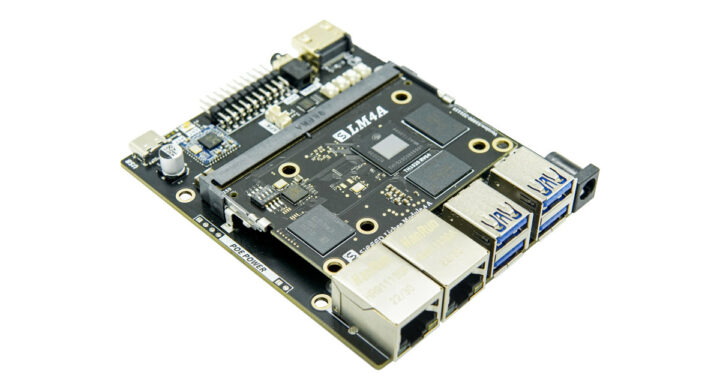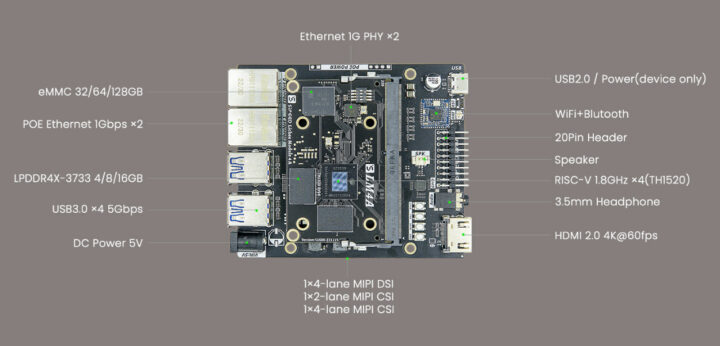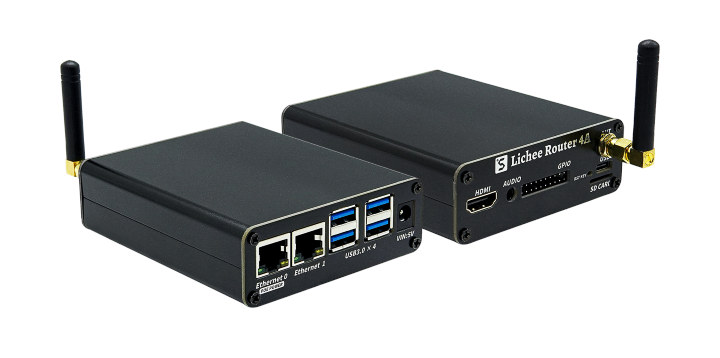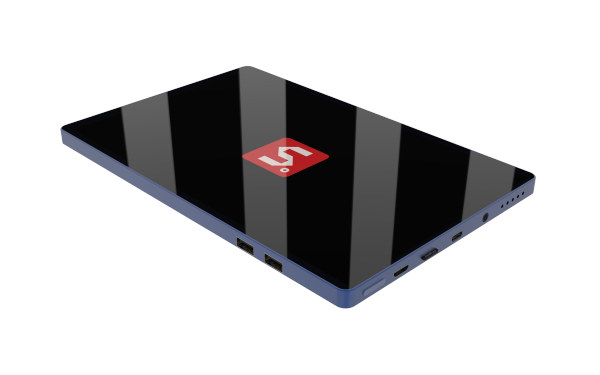Lichee Pi 4A is a single board computer (SBC) powered by Alibaba T-Head TH1520 quad-core RISC-V Xuantie C910 processor @ 2.0 GHz with an Imagination GPU and a 4 TOPS NPU for AI that can compete against the Raspberry Pi 4 in terms of performance and features.
We previously mentioned the Lichee Pi 4A (LPi4A) in our article about the Sipeed LM4A RISC-V system-on-module, but at the time we only had some benchmarks for the board and no photos and specifications about the SBC. Sipeed has now released photos, published detailed specifications, and is taking orders for the board. So let’s have a closer look.
Lichee Pi 4A specifications against the ones for Raspberry Pi 4.
| Lichee Pi 4A | Raspberry Pi 4B | |
|---|---|---|
| CPU | T-Head TH1520, 12nm, 4x RISC-V C910 @ 2.0 GHz | Broadcom BCM2711B0, 28nm, 4x Arm Cortex-A72 @ 1.5 GHz |
| Memory | 4, 8, 16 GB 64-bit LPDDR4X-3733 | 1, 2, 4, 8 GB 32-bit LPDDR4-2400 |
| Storage | MicroSD card OR 16, 32, 64, or 128 GB eMMC flash | MicroSD card |
| GPU | Imagination BXM-4-64 GPU OpenGL ES3.0/3.1/3.2 OpenCL 1.1/1.2/2.0 Vulkan 1.1/1.2 50.7GFLOPS, Fill 3168M pixels/s | Broadcom VideoCore VI OpenGL ES3.1 Vulkan 1.0/1.2 32 GFLOPS |
| NPU | 4 TOPS @ INT8 (1GHz) Supports Tensorflow, ONNX, Caffe | N/A |
| Display | 1x HDMI 2.0 up to 4Kp60 4-lane MIPI DSI up to 4Kp50 | 2x HDMI 2.0 up to 4Kp60 2-lane MIPI DSI 3.5mm AV port |
| Camera | 1x 4-lane MIPI CSI 1x 2-lane MIPI CSI | 2-lane MIPI CSI |
| Video | H.265 & H.264 @ 4Kp75 decode H.265 & H.264 @ 4Kp40 encode | H265 4Kp60fps decode H264 1080p60 decode H264 1080p30 encode |
| Audio | Headphone jack Stereo Speaker PDM MIC | Headphone jack |
| Network | 2x Gigabit Ethernet WiFi 4 or 6 + Bluetooth 5.0 | 1x Gigabit Ethernet WiFi 5 and Bluetooth 5.0 |
| USB | 4x USB 3.0 Type-A 1x USB 2.0 Type-C | 2x USB 3.0 Type-A 2x USB 2.0 Type-A |
| I/Os header | 20-pin GPIO header | 40-pin GPIO header |
| Power | 5V via 5.5mm DC jack or USB Type-C External PoE | 5V via USB type-C up to 3A 5V via GPIO header up to 3A Power over Ethernet via PoE HAT |
The TH1520 used to be advertised at up to 2.5 GHz, but it seems to have now come down to 2.0 GHz. Software support will include Debian, OpenWrt, and Android which should then be posted in the wiki along with the schematics, pinout diagram, and mechanical files. Here are again some benchmarks that were shared in the initial announcement about the LM4A module.
Whether the Lichee Pi 4A or Raspberry Pi 4A is faster will depend on a given application since the platforms are close in the imperfect Dhrystone and CoreMarks benchmarks. RISC-V performance is also likely to improve as the software ecosystem gets more mature. The Imagination BXM-4-64 GPU should be faster than the VideoCore VI based on the GFLOPS numbers provided in the specifications.
The company had already showcased a 7-module cluster board based on LM4A at the time of the first announcement, but they will also release the Lichee Router 4A based on the Lichee Pi 4A SBC, a 6-inch Lichee Phone 4A and a 10.1-inch Lichee Pad 4A all fitted with the LM4A module.
Sipeed has just started taking orders for the Lichee Pi 4A (8GB RAM + 8GB flash) for $119.00 on Aliexpress, and the 16GB RAM version is scheduled for next month. Additional information can be found on the product page.
Thanks to Jim and Mark for the tip.
Updated: This post was initially published on December 27, 2022, and updated once the LicheePi4A board was launched on Aliexpress

Jean-Luc started CNX Software in 2010 as a part-time endeavor, before quitting his job as a software engineering manager, and starting to write daily news, and reviews full time later in 2011.
Support CNX Software! Donate via cryptocurrencies, become a Patron on Patreon, or purchase goods on Amazon or Aliexpress









I’ll wait for it to be available for real, and if not too expensive by then (and if specs don’t significantly drop like the first visionfive) I’ll try to get one to port code to this architecture. Even if not very fast, I’m mostly interested in multi-core for atomic ops, and GbE networking for my tests, so this one looks like a pretty good option.
Sad thing about C910 is that it only implements vector extensions 0.7.1 and gcc and clang went for 1.0.0. Basically that would mean that all vector code would need to be written in assembly and will be hard to transfer to release version of vector extensions or vendor’s compiler must be used (t-head had a compiler that had some quirks around that – they made a intrinsics library that mimics upstream gcc version for 1.0.0, but under the hood used their implementation, at least as far as I can tell by google translating changelogs for their compiler).
t-head is maintaining the 0.7.1 rv64gcv0p7 rvv gcc branch for the various Allwinner D1 boards: https://occ.t-head.cn/community/download?id=4090445921563774976
MIPS flashbacks anyone?
Good to know, thanks for the hint. No big deal for me. I’d really like to test nolibc live instead of under qemu, and make sure haproxy’s atomics work fine on 4 threads under load. Any new platform with its own memory model is nice to detect consistency bugs in code.
IMO, c910 has no vector extension. Only c906 and c908 have it.
> IMO, c910 has no vector extension
https://github.com/ThomasKaiser/sbc-bench/blob/master/results/cpuinfo/T-Head-C910-5.10.4.cpuinfo#L11
Article announcing C908. for those of me who just assumed that 910 would be a newer release that 906/7/8. 🙂
Will schematics be available for module and motherboard?
Of course, but sourcing that chip may be impossible.
Will the cnx software site be allowed one to test, assuming Jean- Luc has time to spare?
I’ll be testing the VisionFive 2 first, I should receive it in the next few weeks. We still have time for the Lichee Pi 4A.
i’d be more interested in a comparison to the visionfive 2 (JH7110 with 4xU74). According to their benchmarks, the C910 is supposedly twice as fast as the U74. With double the IPC for the C910. Seems a bit too good to be true… even Alibaba only advertises a 40% uplift over the U74…
The numbers for the JH7110 may not be accurate/updated in the chart provided by Sipeed. This was shortly discussed @ https://www.cnx-software.com/2022/12/14/sipeed-lm4a-t-head-th1520-risc-v-module-to-power-raspberry-pi-4-competitor-and-cluster-board/#comment-603940
C910 vs u74 gives somewhat similar performances differences like cortex a73 vs cortex a55, per clock.
I have rvb-ice board with dual core c910 and I have jh7100 based board, though later one have some design issues that cripples it, but basic benchmarks shows about that level of differences
So will it have backdoors for CCP to get in ?
Yes, but only doors for CCP affiliated ants.
Sounds pretty good but I guess ” Imagination GPU” mean binary closed source driver that will stop to work in 3 or 4 years with new kernel …
Isn’t there an ARM or RISC-V platform in 2023 with mainline support including GPU that could compete with let’s say Intel pentium ?
Imagination are working on an open source Vulkan driver.
https://www.phoronix.com/news/Open-Source-PowerVR-Vulkan
PowerVR driver is not the same as BXE
So sharing that links makes no sense.
Please vote if you prefer this one or VisionFive 2
https://mobile.twitter.com/RpxDeveloper/status/1608148210182127618?s=20&t=EBHY2a-vubxpiwO_T2beZQ
I’m paticularly excited by this RISC-V SoM, and sbc.
It has sufficiency of performance.
It’s been designed in such a way as to be modular and versatile.
And it’s built using open sourced chips.
I will certainly be buying at least one of these boards, as soon as the software becomes easily bootable. Over to you, Debian!
In the specs table under power there is “External PoE”. What does that mean please? Does that require some adapter or GPIO hat?
i would imagine they mean a POE splitter can be used… so no real support for any sort of POE.
something like this, perhaps:
https://www.amazon.com/ANVISION-Splitter-Adapter-Connector-Compliant/dp/B082RNW8XJ/
When you look at the photo of the board from the top, you see 6 pads close to the left edge, marked “POE. This is for an optional POE module as is used on various boards. It’s likely connected via 4 pins to the center points of one of the ethernet jacks and the two pins likely deliver the required 12V to the board. It’s a pretty common design, they most likely rely on a standard module so that they don’t have to reinvent theirs. If you google for “POE pcb module”, you’ll see plenty of them. I think this… Read more »
It would be perfect if the 910 core supports RVV 1.0
IMO, no rvv at all in c910
I went as far as being about to pay, but the eMMC is soldered and I know that I will regret not waiting a bit to get more than 8G for a dev machine; toolchains and dependencies are sometimes huge and I’m often short on other machines with similar sizes. Thus I gave up and prefer to wait a bit more for a model with more storage.
excited about 21. century RAM concepts, what’s the summarized RAM of all boards newer than DDR3 ($3-5/GB) for customers? With some few devices on a 2023 yrs base for hardware and software devs this possibly very fast exceeds a 100GB number (idling RAM percentage?)
I was not speaking about the RAM but the eMMC. I’m perfectly fine with 8G of RAM, most of my machines have much less and are happy with it. But 8G of storage when you install an ubuntu-like distro with some development tools can quickly become scarce nowadays (experienced a few times already). Other vendors use pluggable eMMC modules so you take what you need. Here you have to deal with a soldered module, so if you suspect you’ll be too short, you can’t upgrade it later. That’s my concern.
Yes 8GB is limited but there is a SD card slot on the underside of the board to install a rootfs on. On the VisionFive 2 they didn’t trace out 1.8v io mode for hs200/400 speed mode.
Visionfive2 has nvme m2 slot which both cheaper and faster than sd card
This is a “beta” release. They have confirmed that booting from flash/SD is broken and can only boot from EMMC. So probably a lot of games to get it booting from SD.
The images/burning process seems pretty rudimentary at the moment. Something along the lines of fast boot.
“toolchains and dependencies are sometimes huge” maybe i thought natively compiling can sometimes be limited with 4GB RAM (sorry, yes emphasis is clearly on storage (avoiding snap dependencies?) with reading again)
Looks similar to the StarFive Vision2. Software support is “bare” and it seems to overheat. The cpu frequency seems all over the place 2ghz then 1.8, another person in the comments posted snipped with 1.2GHz.
The GPU is supposed to be open but the drivers are for some odd kernel version and not maintained.
It is good to see these risc-v boards, but it seems to me these are alpha silicon quality.
wrt CPU frequency is ws 1.8 GHz in the first announcement in December, but it’s been changed to 2.0 GHz now. I did update the specs but missed the frequency in the introduction.
They confirmed 1.8Ghz on the wiki as shipped and say maybe 80% of boards can clock to 2Ghz but unstable.
(View the chinese version of the Wiki, the English version has not been updated)
Drivers for GPU are not ready yet so this is a dev board only.
slarm64 images